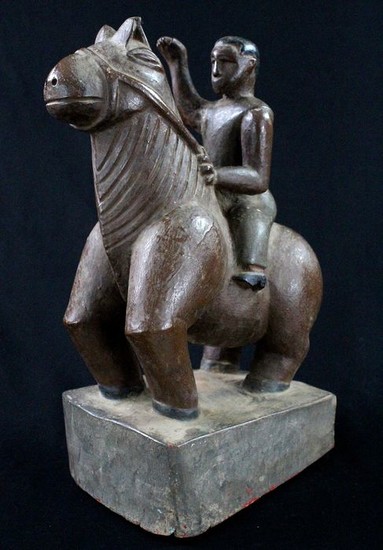Impressive "colon" horseman - Wood - Fante - Ghana
Beautiful "colon" horse rider, from the Fante tribe, Ghana. Amazing proportions, with a huge and powerful horse, while the horseman is comparatively of small size. Used by diviners in most Akan tribes (the horse is considered as a bridge between the real and the mystic world) , the proportions of the horse and the horseman are explained by their spiritual power. The strenght of the horse is much higher than the one of the horserider, hence the difference in terms of size. The item is carved in a wood of high density. An old wood crack is visible on the pictures. 1950s to early 1960s. Painted statuettes cover a wide variety of areas in Africa. Generally dedicated to the worship of ancestors, geniuses of fertility or divination, they are found on altars, canoes, in houses or carried on either, in tribes as different as Yoruba, Fanti, Akan, Ewe etc. They appeared with colonization, hence their name. Contrary to what is said according to some sources, they are not intended to ridicule the "white man". By appropriating the power of the colonist, presented with an accessory of European origin, they participate in the animist cult. The colonist continues to be born, in certain ethnic groups, and to appear according to the rites, customs and traditions of ancestral Africa. To fall in love with these statuettes with fun looks and silhouettes. you don't have to be passionate about the culture of African societies or to love traditional art. This is one of the specific features of this expression of "Art Colon. " The touching and tender side, the laughter, awakens the fiber of the child that sleeps in each of us. Statuettes reflections, pivotal statuettes, they express a whole slice of history, and even for those who know a little to dream, a whole slice of the future. References : Statues colons, Werewere Liking, Les Nouvelles Editions africaines Le courant Colon, Alain Guillemain et Yacouba. Konate, Les arts traditionnels de Cöte d’Ivoire Art colon et style tribal, Vente du 8/03/87, Binoche et Godeau « Colons », vente du 25 Octobre 1987, Binoche et Godeau Colon, Das Schwarze Bild vom Weissen Mann, Herausgegeben Von Jens Jahn La statuaire non colon, Baoulé, Agni, Lobi, Senoufo, Ewe, Alain Larem, Antonio Tocon Le colon touristique Baoulé et le jouet profane et culturel, Alain Larem African Art Western Eyes , Suzan Vogel Dreams and Reverie, Philip L. Ravenhill Mami Wata, Arts for Water Spirits in Africa and its Diasporas
[ translate ]View it on
Estimate
Time, Location
Auction House
Beautiful "colon" horse rider, from the Fante tribe, Ghana. Amazing proportions, with a huge and powerful horse, while the horseman is comparatively of small size. Used by diviners in most Akan tribes (the horse is considered as a bridge between the real and the mystic world) , the proportions of the horse and the horseman are explained by their spiritual power. The strenght of the horse is much higher than the one of the horserider, hence the difference in terms of size. The item is carved in a wood of high density. An old wood crack is visible on the pictures. 1950s to early 1960s. Painted statuettes cover a wide variety of areas in Africa. Generally dedicated to the worship of ancestors, geniuses of fertility or divination, they are found on altars, canoes, in houses or carried on either, in tribes as different as Yoruba, Fanti, Akan, Ewe etc. They appeared with colonization, hence their name. Contrary to what is said according to some sources, they are not intended to ridicule the "white man". By appropriating the power of the colonist, presented with an accessory of European origin, they participate in the animist cult. The colonist continues to be born, in certain ethnic groups, and to appear according to the rites, customs and traditions of ancestral Africa. To fall in love with these statuettes with fun looks and silhouettes. you don't have to be passionate about the culture of African societies or to love traditional art. This is one of the specific features of this expression of "Art Colon. " The touching and tender side, the laughter, awakens the fiber of the child that sleeps in each of us. Statuettes reflections, pivotal statuettes, they express a whole slice of history, and even for those who know a little to dream, a whole slice of the future. References : Statues colons, Werewere Liking, Les Nouvelles Editions africaines Le courant Colon, Alain Guillemain et Yacouba. Konate, Les arts traditionnels de Cöte d’Ivoire Art colon et style tribal, Vente du 8/03/87, Binoche et Godeau « Colons », vente du 25 Octobre 1987, Binoche et Godeau Colon, Das Schwarze Bild vom Weissen Mann, Herausgegeben Von Jens Jahn La statuaire non colon, Baoulé, Agni, Lobi, Senoufo, Ewe, Alain Larem, Antonio Tocon Le colon touristique Baoulé et le jouet profane et culturel, Alain Larem African Art Western Eyes , Suzan Vogel Dreams and Reverie, Philip L. Ravenhill Mami Wata, Arts for Water Spirits in Africa and its Diasporas
[ translate ]


